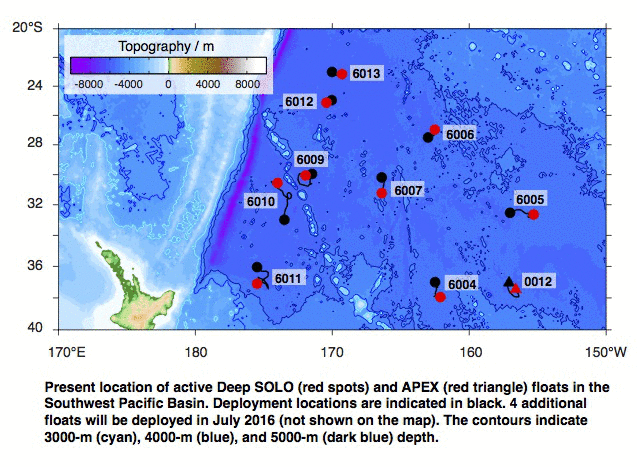Abstract's details
Deep Ocean contributions to sea level and heat content variability in the Subtropical South Pacific: Early insights from a pilot deep Argo array
Event: 2016 Ocean Surface Topography Science Team Meeting
Session: Science II: From large-scale oceanography to coastal and shelf processes
Presentation type: Poster
Estimates of the contribution of seawater density to changes in sea surface height (SSH) suffer large uncertainties caused by a lack of deep-ocean temperature and salinity data. The development of a new generation of deep-profiling Argo floats, capable of observing temperature and salinity to the ocean bottom (6000 m), will help fill this need. The regional Deep Argo array in the Southwest Pacific Basin counts 10 active Deep Argo floats. This includes 7 Deep SOLO floats and 1 Deep APEX float deployed in January-February 2016, and 2 Deep SOLO floats in June 2016. Deployment of 4 additional floats, including 3 Deep SOLOs and 1 Deep APEX float, planned for July 2016, will bring the Deep Argo regional array to 14 floats. Here, performances of the Deep SOLO and Deep APEX floats, and accuracy of the SBE-61 CTDs, mounted on the Deep Argo floats in the Southwest Pacific pilot array, will be discussed. The increasing coverage in the regional array and the availability of reference data from shipboard repeat hydrographic transects will enable the assessment of SBE-61 float profile data. Preliminary results on SSH variability in relation to subsurface ocean variability, including both the upper ocean (0-2000 m) and the deep ocean (2000 m to the bottom) components, will be shown. Long-term goals are to (i) advance current understanding of the partitioning of changes in SSH into upper and deep ocean steric components as well as mass, (ii) enhance our knowledge of ocean circulation and meridional overturning transports, contributing to the redistribution of heat, salt, and water masses in the deep ocean, and iii) assess the sensor and sampling errors of a deep float array in monitoring the 2000m-bottom heat and freshwater inventory changes.

Back to the list of abstract